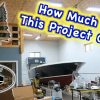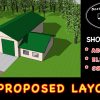http://blip.tv/boatworks-today/using-awlgrip-545-primer-over-fiberglass-repairs-6133839
This episode continues through the finishing process after making the various fiberglass repairs around the boat. The primer is applied and sanded with the first coat of Awlgrip paint rolled and tipped. The next episode will go over adding the non-skid texture and finishing the project! Visit our website for more additional information www.boatworkstoday.com and follow us on Facebook and Twitter!
Materials used in this episode:
~ Awlgrip 545 Primer (White) mixed 1:1 with coverter
~ Awlgrip topside paint, Awlcat #3 brush converter mixed 2:1 and reduced with T0031 brushing thinner (maximum 33% of volume)
~ Seafit 3/16″ Mohair roller
Things to Remember!!
~ Awlgrip has 2 different lines of topside paints; Awlgrip and Awlcraft 2000
~ Awlcraft 2000 paint is for spray application only and is able to be buffed for repairs.
~ Awlgrip is able to be sprayed OR rolled / tipped but is not meant to be buffed for blending repairs. Buffing this paint will shorten the life of the paint and will tend to fade faster than the surrounding painted areas that were NOT buffed. What does this mean? You’ll have a faded blotch that stands out by the following year :-O
Please ‘Like’ or ‘Share’ above and join the discussion below in our comments section!!
Also, please remember that there are extended ad-free versions of these video’s available for Patreon supporters! Please click below to find out more.










Enjoyed the latest video installment. What brand of grease and wax remover do you use?
I used a couple of different products; Primarily I used this http://www.autobodymaster.com/product_list.jsp?PHPRJ_GROUP_ID=37091 mostly because it’s inexpensive, but I also used Awlgrips product called Awl-Prep Plus (both do the same thing). I really only needed one or the other, but by going over it twice it gave me a little added peace of mind 🙂
Thanks for the comment!
Hi, I really like your show. Is my first time painting a boat, it’s a 23′ Mako as far as i know it was painted with( white Urethane), I will like to use the product you’r using,what will be the right method to use for this project and where can i get this product I’m located in Miami fl.
Hi Jim,
Thanks for the kind words 🙂 A couple things that I would look at if this were my project.
Are you sure the surface was painted and it isn’t the original gelcoat?
Assuming that it was painted, you’ll need to do some testing to see what kind of paint it is; one part or two part (I used a 2-part paint in the videos.) A one part paint means that no catalyst or hardener is needed for it to fully cure. A two part paint requires a hardener.
The reason this is important is because a 2-part paint CANNOT be applied over an existing surface that is coated with a 1-part paint or primer!! The new paint will melt the existing surface and give you a really bad day :-O Awlgrips guidelines for testing can be found here
If you are able to send me some pics I might be able to point you in the right direction. Maybe a couple close-ups and a couple overall boat pics??
Thanks!
~Andy
Been watching the vids – great info. I get really confused at some things though. When fixing chips etc -because I have one or two on my outer gunwale I need to do – isnt that gel coat your repairing and dont you need to use gelcoat ? I have a parker 1801 and have seen other vids and they use all the same prep process but use gel coat instead of that filler you did . Is their a reason why ? I dont want to paint my boat for a chip – or am i just way off here. Thanks
Hey Eric,
Technically the compound / thick putty that I am using to fill in the chips is actually a type of gelcoat. I use this material for quick repairs as it sets up in a few minutes rather than a few hours compared to the thin type of gelcoat. If I am going to be going back over the fill with color matched gelcoat rather than paint then I will sand a shallow dimple into the filler and lay the color matched gelcoat over that. Once it cures then wetsand and finish as you would a normal gelcoat repair.
One of the advantages of using the fast set filler for the prep is that you can make sure that the surface is actually filled before laying the colored gel. Otherwise you run into the risk of having a low spot when you go to finish sand the repair requiring more gelcoat to be applied. It’s essentially a time saver as once I prep the area and lay the colored gel I know that the following day all I have to do is sand and polish; no possibility of having to lay up more material and be on hold for yet another day 🙂
This Winter I am going to be doing a detailed series on gelcoat covering everything from prep, color matching, application and finishing. It will be another series of videos (probably one vid per topic). I have a feeling that a lot of people are going to find it very useful!
Let me know if you have any further Q’s!
Thanks 🙂
~Andy
Enjoy your videos very much. Lots of good information and well presented.
I am currently refinishing a drift boat that I use in my business.
It is a polyester laid up boat about ten years old. I did all the prep work and it is to the point of painting or gel coating. It is upside down in my garage. I am only dealing with the bottom right now. After ten years there was a lot of gouges, scrapes and nicks from rocks jumping up a hitting the boat.
I want to wait for warmer weather so I can work outside or at least sand outside. What do you recommend for a temp finish or primer to get me til Spring. It will be in the water quite a bit ’til then.
I used Evercoat Formula 27 for filler.
Thanks in advance, Jim
Great videos….I am working on a 1982 13′ Boston Whaler…All of the primering and painting you showed in your videos were on horizontal sufaces. Do your same techniques able to a vertical surface?
Thanks!
Andy
Yup 🙂 Only other thing I would stress from the video is if you apply the paint by rolling / tipping make sure to try and squeeze as much of the paint off the roller (in the try) before rolling the paint onto the boat! This stuff is VERY thin and will run if it’s put on too heavy. Apply very thin coats keeping in mind that you’ll need to apply 2-3 coats before you have full coverage..
Good luck!
~Andy
Andy,
I really enjoy your videos, very informative and interesting. I need to do a deck repair on a soft spot on my 38ft sailboat. The deck has a like a roller stipple finish in the gel coat, but the non skid is not good. I am going to remove the top skin and replace core and redo the whole deck with Alwgrip and ad there sprinkle texture in the paint. I saw in one of your videos where you had and attachment to put on your sander to clean the gelcoat. Do you think that would work to rough the surface for 545 primer? Any other tips or suggestions you have would be appreciated. Oh yea, congrats on your second!
Thanks, Russell
Hey Russell,
Thanks for the kind words 🙂 I don’t know that the brush would be a good choice for going over the 545 primer. Not really sure what would happen but I would guess that either it would create swirl gouges OR not be aggressive enough to rough the surface for proper paint adhesion; I’m guessing the latter..
My experience says the best thing to do is to sand the primer with 220-320 grit paper. When it comes time for ordering the paint, make sure you get Awlgrip (and not awlcraft2000). Both are made by Awlgrip but only the true Awlgrip can be rolled. The other has to be sprayed…
When you get closer to the project let me know if you have any Q’s!!
~Andy
Great info on laying down the non-skid. I have one questionon concerning applying the Topcoat over the primer. Why was the first coat mixed 2:1 and the other coats mixed 1:1? Seems like they would be the same. Did I miss something?
Hi Bob,
Good catch on that detail 🙂 The reason the mixing ratio’s changed was because of the flattening agent. On the coats where this was not used the standard mix is 2:1 and reduce with thinner up to 30%. However, when working with the flattening agent the ratio’s need to be changed (these are Awlgrip’s instructions) to a 1:1:1:1 meaning equal parts of the base color, catalyst, thinner and flattening agent. This ratio will result in a true “flat” finish. If you wanted to get more of a semi-gloss appearance then the ratio’s would still be equal parts of everything EXCEPT the flattening agent; that would be cut by half 🙂
Hope this helps!
Looking for molds or patterns for non-skids topcoat after fiberglass repairs.
thanks.
Capt. Russ
Are you looking to blend a repair into existing non-skid, or starting over from scratch?
I really enjoyed the video. Very informative. Presently refitting a 44 ft sailboat. Just did the lazaretto and propane locker hatch covers with your info and they have turned out quite well. They were new covers that I’d built and the grip tex finishing is straight forward when following your recommendations.
Question:
The whole deck of this boat has been previously repainted using Awl Grip…. years ago. It appears that Grip Tex was added to the deck at the same time. Can you offer suggestions on how to deal with repainting where the Grip Tex is located? Do I need to completely sand the deck to remove the old Grip Tex or is there a way to paint over the existing substrate while adding more to refresh the non-skid?
Thanks
Hi. I like your video very much. They are the most informative. West systems says you can apply gelcoat over there epoxy if you follow the right steps and make sure the epoxy is 100% dry. You said that you can only apply gelcoat over poly and not over epoxy. Do you have any insight here?
Going to be doing some experimenting on this in the next set of video’s!
I really enjoy your videos but i cant view all of them? Only the ones via youtube
question for you: I have refinished a large pool slide and in the past have use the Mathews Low VOC paint for my topcoat and I am considering using Awl Grip as an alternative. How do you feel this may hold up and work as this application? Also the pool area has some beach sand that does get on the sliding surface. I know this is out of the normal scope of what Awl Grip is used for but there is nothing good on the market to provide a premium surface over the fiberglass slide.